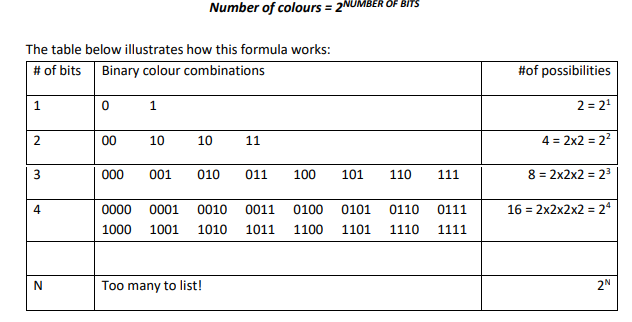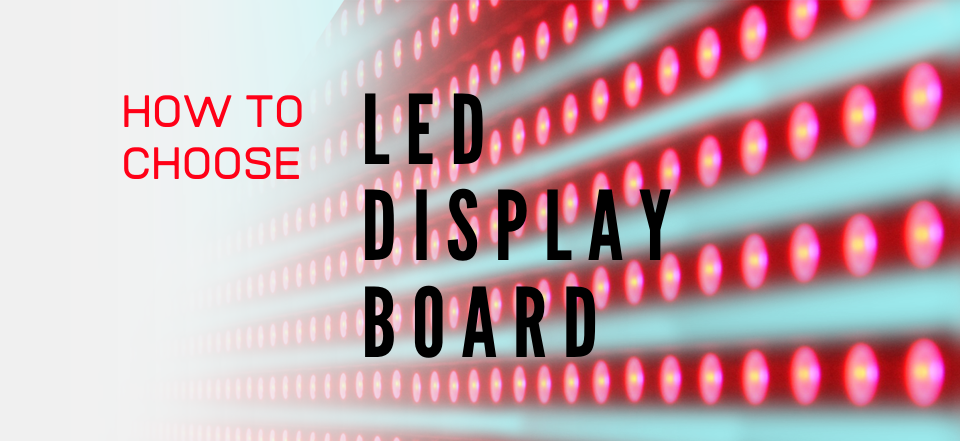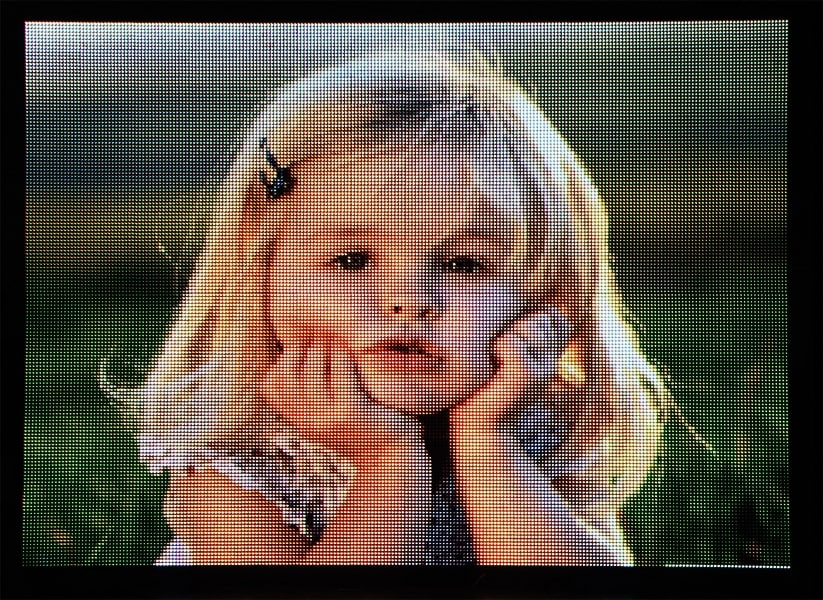LED displays are used as main source for interaction between user and systems. Reasons for using LED Displays are, it is more efficient, consumes less energy and emits more light sources with high intensity. Choosing LED Display boards depends on actual needs of customers like indoor, outdoor, single color or multi color etc. Let us understand the basics to choose LED Display board.
1. What is an LED?
Light Emitting Diodes (LEDs) are small lamps that emit light when supplied with electricity. They come in many colours and shapes. Unlike incandescent lamps that convert electricity to heat and light with a filament, LEDs convert electricity directly into light, have no breakable filament and are extremely efficient. LEDs are perfect for use in creating displays because of their high brightness, extremely long lifetime, and their very small size. Most LEDs are less than 1/4th inch in diameter. Unlike incandescent bulbs which last just 1000 to 2000 hours, the useful lifetime of LEDs that go into Efftronics LED display signs last typically for 10 years
2. What is pixel?
The word “Pixel” is an acronym for “picture element.” Pixels are small points of coloured light on a display surface that combine to form an image. If you look very close at your television, you can see the individual pixels that make up the screen.
3. How to LED displays create images?
LED displays create images using pixels made with LEDs. In a red or amber monochrome LED display, each pixel is normally made with just one red or amber LED. In a colour LED display, pixels are made with three LEDs (red, green, and blue) grouped together. Since any colour can be made by mixing red, green, and blue light of various strengths, the exact colour of each pixel can be controlled by precisely controlling the light output from each LED.
4. What does pixel pitch mean?
“Pitch” is the centre-to-centre distance between pixels in a display, usually given in millimetres (mm). A smaller pitch means more tightly packed pixels and, therefore, higher resolution. Efftronics offers both 10 mm and 16 mm pixel pitch products for a range of applications.
5. What does resolution mean?
Resolution describes the ability of a display to show image details. In general, a display with a larger number of pixels (smaller pitch) will have a higher resolution, and a display with fewer pixels (larger pitch) will have lower resolution.
6. What is a matrix?
A “matrix” is a collection of pixels in a display surface arranged in a rectangular grid. A display matrix is usually described in terms of its size by the following: Number of pixels high x Number of pixels wide
7. What is the difference between red or amber LED signs and full color LED signs?
Monochrome displays produce images of one colour only. Typically red or amber, monochrome displays are used to display text. By contrast, full colour LED displays are capable of displaying true color images and video.
8. What is viewing angle for an LED display, and how is it measured?
Viewing angle describes the ability of a display to show images when viewed from a non-head-on direction. As one moves from viewing the display head-on, to 90 degrees from head on, the display brightness drops from 100% to zero gradually. At a certain angle, the brightness of the display will drop to half of its head-on brightness. Because the display is symmetrical, whether viewed from left of right, 2x this half-brightness angle is defined as the view angle. The horizontal and vertical view angles for displays are usually different. The horizontal view angle is usually wider than the vertical view angle to capture a wider audience and avoid directing light into the sky. Therefore, horizontal and vertical view angles are usually given separately.
9. What are the key factors affecting image quality of full color display?
a. Pixel pitch
The density of LEDs is the leading determinant of image clarity – the more LEDs per square foot, the smoother the image. The closer a viewer is to an LED display the more the LED density comes into play.
b. Contrast
Because LED displays are often used in brightly lit environments, especially in sunlit outdoor environments, it is important that the display surface does not reflect light. Reflected light will compete with LED light produced by the display to form images and cause a “wash out” effect where the image loses visibility. Efftronics LED displays use nonreflective type PCB grills on front side or Anti-reflective polycarbonate sheet.
c. Colour uniformity
Colour uniformity refers to how smooth an image will appear across the surface of a display. Because LEDs are produced in batches by manufacturers, slight variations may occur in the amount of light that they produce from batch to batch—this is true even for amongst the world’s best suppliers. Efftronics displays are manufactured such that same batch LEDs are assembled in one entire display.
d. Colour accuracy
In addition to producing an image with uniform colour, it is important that the colour of image produced is true to life. A perfectly uniform image that is too reddish in colour, for example, will not look right. Efftronics takes care of this uniform color distribution and perfect white balance.
e. Frame rate
Videos are created on displays by rapidly flipping images at speeds too fast for your eye to detect. The images that compose a video are called ‘frames’. The speed of image play is called “fame rate” and is measured in “frames per second” or FPS. The faster the frame rate, the smoother the video will appear to the eye. Efftronics displays are capable of playing images at a rapid frame rate of up to 60 frames per second—the same as for most computer monitors.
10. What are the main components in an LED sign?
Efftronics displays are made with a minimal component count and simplicity of construction for reliability, and ease of serviceability. Broadly speaking, each display comprises of LED modules, Buffer module, Controller module (mono-colour) /Transmitter module (Full colour), Receiver module (Full colour), Power supplies & mechanical cabinet. Each of these is described in more detail below.
a. LED modules
There will be various sizes of display modules like 16×32, 16×48, 8×16 etc. The size of module depends on application. In case of outdoor application, each module is sealed with weather proof potting.
b. Buffer modules
In order to extend the signals to more distances buffer driver module will be used. In general, these will help providing required signal strengthening. c. Controller module
All the mono-colour LED modules will be controlled by controller module. It will be having enough memory to store language fonts, backup messages etc. Different types of controller modules will be available to support various sizes of display signs.
d. Transmitter module
All the full colour LED modules will be controlled by Transmitter module via Receiver module. This module takes DVI/HDMI signal input capturing video frame and transmits frame packets intelligently via ethernet to all the receiver modules which in turn control LED modules.
e. Receiver modules
For every group of LED modules (varies with design) for ex: 64×64 LED matrix, one receiver module will be required. Receiver module decodes the image packet frame it receives and generates LED module output.
f. Power supplies
LED modules typically require low voltages such as 3.3V/5V to operate. Power supplies convert 170-260V AC electricity to 3.3V/5V electricity that LED modules need to operate.
g. Mechanical cabinet
LED tiles are mounted to a skeleton of extruded aluminium/MS rails. This aluminium/MS skeleton is rigid and corrosion resistant, to ensure that the display will last and be looking great over its entire lifetime and keep LED modules perfectly aligned for a seamless image at all times.
11. What goes into a LED module?
a. LEDs
LEDs are the single biggest determining factor of display quality and lifetime. Tremendous variability exists amongst LED suppliers in terms of both cost and quality. LED prices can range from 1rupee to 10rupee each, and operating lifetimes can range from less than 1yr to more than 15 years. Often, producers of low-end LEDs make unscrupulous claims that their LEDs rival the quality of the premium products. Not true. This variability is a major source of the price differences existing amongst LED display suppliers, particularly suppliers based in China and Taiwan. In general, only a handful of Tier 1 LED suppliers produce products worthy of Efftronics LED displays. Efftronics selects only LEDs from Tier 1 suppliers such as NICHIA/AVAGO/OSRAM/CREE.
b. Printed Circuit Board (PCB)
A printed circuit board (PCB) is used to mount the electronic components, including LEDs and driver chips together in each display module. Printed circuit boards consist of two/multiple copper layers sandwiched between fiberglass reinforced polymer insulators. Together, the copper layers and insulators make up the circuit that drives each LED. Efftronics uses PCBs made up of FR-4 grade with minimum 35 microns start/base copper thickness only where as low end manufacturers use 17 micron start/base copper to reduce cost compromising the quality.
c. LED driver chip
LED driver Integrated circuits are used to control the brightness of each and every LED in a display module. Each chip translate a digital signal into the exact colour (PWM signal) needed for each pixel to produce a vibrant image. Efftronics use worlds best LED drivers from macroblock which are high grade components unlike Chinese variants.
d. Front cover & plastic Base
A front cover is placed over the LEDs to provide impact resistance, contrast, and shielding from sunlight. Plastic base is used to protect the LED module PCB and also facilitates horizontal and vertical cascading of LED modules. Efftronics use high grade non-reflective plastic for front cover grill and base.
12. What product options does Efftronics offer, and how do I choose the right one?
Choosing the optimal resolution for an application means striking a balance between pixel density and cost. Higher pixel density (smaller pitch) displays are needed to produce great looking images at close viewing distance. Higher pitch screens can be used at larger distances while maintaining image quality. Efftronics offers 20 mm, 16 mm, 10 mm pitch products for outdoor and 10mm, 7.62mm for indoor use. We are also capable of customizing to any pitches.
13. How many colours can an LED display produce?
Often modern displays are said to be capable of producing “billions”, “trillions”, or even more possible colours. By mixing red, green and blue LED light in various combinations, different colours are produced by each pixel. Generally speaking, our eye will not be able to resolve the difference between anything more than billions of colours. For reference, a high quality true colour computer monitor produces millions of colours. The exact mix of red green and blue LED light in each pixel, and therefore the exact colour of each pixel, is controlled digitally through a binary numbering system of 1s and 0s called ‘bits’. A larger number of bits mean a larger number of colour possibilities. In general, the number of colours will grow exponentially with the number of bits according to the formula below.

As an example, 12-bit control of red, green and blue LEDs will give a total of 36 bits of control per red-green-blue pixel, and will give 236 = 68,719,476,736, or a little over 68 billion colours. Similarly, 16-bit control of red, green and blue LEDs will give a total of 48 bits of control per redgreen-blue pixel, and will give 248 = 281,474,976,710,656, or a little over 281 trillion colours.
Cost
1. What type of price variation exists for LED display products?
LED display pricing is truly one of the most confusing aspects for potential buyers, and deserves serious attention. Large variations in price and quality currently exist amongst LED sign suppliers. Pricing from supplier-to-supplier for supposedly similar products varies wildly.
Given this variability, buyers need to know exactly the type of product they are getting for their money and what kind of return on investment can be achieved with the product.
Some suppliers produce LED display products that have an intentional lifespan of only 2-3 years. A large percentage of products, if not the majority, offered by Chinese suppliers fall into this category. Low-cost, short-lifetime products have enjoyed success in emerging markets where labour costs are low, allowing displays to be affordably replaced every few years and regularly repaired. By contrast, long lasting products have been highly successful where replacement of displays every few years and frequent need for servicing is not viable due to higher labour costs. Efftronics falls into the second category, producing products that can easily last for 10-15 years. Buyers need to be fully informed about the product decision that they are making. Unfortunately, unscrupulous suppliers frequently attempt to sell low-cost short-lifetime products as high-quality. The newness of the LED display market and the lack of buyer education when it comes to LED display quality allow some buyers to be taken in. It is important to us that our customers have the information they need to make a confident choice.
2. How are Low-cost suppliers able to cut costs, and how do these decisions affect quality?
The following section lists measures that some suppliers use to cut costs, and the corresponding quality impacts:
Low-grade LEDs
- Degrade faster: can look good initially, but will look poor or cease functioning altogether in just a few years, if not sooner.
- Have poor LED sorting (also known as “binning”) that causes displays to become visually non-uniform.
- Draw more power to achieve the same brightness level as a quality LED product
- Made with low-grade lenses that ‘yellow’ in sunlight, causing LEDs to discolour over time.
- Have non-watertight LED packages that allow water to seep into and damage the active light emitting part.
- Can cost less than 1/4 the price of high quality LEDs that will last 100,000 hours.
“Knock-off” LED driver chips
- Susceptible to electrical damages because of poor quality control and engineering as compared to reputable and reliable chip suppliers including Texas instruments, Macroblock ,Toshiba etc.
- Offer smaller brightness ranges, lower efficiency, and imprecise control of LED brightness.
Printed circuit board (PCB):
- PCBs with low base and finish copper.
- With overall low thickness.
Low-grade power supplies
- Often the weakest link in displays
- Produced with inferior electronic components, particularly electrolytic capacitors that are rated for only a couple years of continuous usage.
- Often have lower efficiency, and will consume more power.
Poor thermal consideration
- Entire design allow raise of temperature upto 40 degrees centigrade by overrating electronics which is not at all suitable to Indian/Hot environmental conditions as outside ambient temperature itself is 50 degrees centigrade in summer. This will derate the system and may fail fast.
Designed for low brightness
For hot and bright Indian conditions, it is recommended to have display brightness of 7500 cd/m2 or nits. Some manufactures claim very much less than that and say it is suitable to outdoor Indian conditions. In reality, it is only to reduce cost of the display. Some manufacturers claim that they provide 7500 cd/m2 displays but in reality allow more temperature rise there by compromising the product life.
LED Displays Reliability, Lifetime & Servicing
1. What are the three most important results that LED display buyers should expect from a quality product?
- The LED display has to start and stay beautiful for the longest possible time
- Expensive downtime needs to be minimized or eliminated
- Future investment in repair and service needs to be minimized or eliminated
2. How can I be sure I’m buying a quality product?
Does a manufacturer trust its own product with a warranty? This is evident by how much a manufacturer is willing to risk in terms of providing you a long warranty period and how comprehensive your coverage will be.
Efftronics offers a 1-year warranty on every LED display sign. It covers all electronic and LED components in the display sign. There is no need to upgrade to have full coverage, and no need to pay extra. Efftronics also offers extended warranty up-to 5 years on price basis which includes comprehensive warranty beyond which we also take Annual Maintenance Contract.
3. How long should I expect my LED display to last?
Typically 10 years. Under laboratory testing simulating environmental conditions, our display signs are able to operate without any much degradation in brightness. We use tier 1 grade LEDs which can retain 50% of their initial brightness after 50,000 hours of full brightness continuous operation.
4. What kind of service, maintenance, and technical support should I expect?
We will provide complete support during and after display sign installation. This support includes all of the following: training on software and hardware, customer support to answer your questions, access to our continually updated online resources, and our warranty. Email: displays@efftronics.com Telephone: +91 866 2466675
5. How do displays perform in extreme environments?
Our display signs are designed for extremities of Indian environment conditions.

